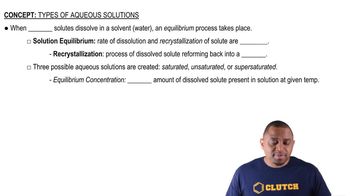Balance each redox reaction occurring in acidic aqueous solution. a. K(s) + Cr3+(aq) → Cr(s) + K+(aq) b. Al(s) + Fe2+(aq) → Al3+(aq) + Fe(s)
Ch.19 - Electrochemistry
Chapter 19, Problem 38b
Balance each redox reaction occurring in acidic aqueous solution. b. Mg(s) + Cr3+(aq) → Mg2+(aq) + Cr(s)
 Verified step by step guidance
Verified step by step guidance1
Identify the oxidation states of each element in the reactants and products. Magnesium (Mg) starts as 0 in its elemental form and is +2 in Mg2+. Chromium (Cr) starts as +3 in Cr3+ and is 0 in its elemental form Cr.
Write the half-reactions for both oxidation and reduction. Oxidation: Mg(s) → Mg2+(aq) + 2e-. Reduction: Cr3+(aq) + 3e- → Cr(s).
Balance the electrons in the half-reactions. The oxidation half-reaction already has 2 electrons. Multiply the reduction half-reaction by 2 to balance the number of electrons: 2Cr3+(aq) + 6e- → 2Cr(s).
Combine the balanced half-reactions. Ensure that the electrons are canceled out: Mg(s) + 2Cr3+(aq) → Mg2+(aq) + 2Cr(s) + 2e- - 6e-.
Check that all atoms and charges are balanced in the final equation. The final balanced equation should be: 3Mg(s) + 2Cr3+(aq) → 3Mg2+(aq) + 2Cr(s).

Verified Solution
Video duration:
4mWas this helpful?
Key Concepts
Here are the essential concepts you must grasp in order to answer the question correctly.
Redox Reactions
Redox reactions, or reduction-oxidation reactions, involve the transfer of electrons between two species. In these reactions, one species is oxidized (loses electrons) while another is reduced (gains electrons). Understanding the oxidation states of the elements involved is crucial for identifying which species undergo oxidation and reduction.
Recommended video:
Guided course

Identifying Redox Reactions
Balancing Redox Reactions
Balancing redox reactions requires ensuring that both mass and charge are conserved. This often involves separating the reaction into half-reactions: one for oxidation and one for reduction. In acidic solutions, hydrogen ions (H+) and water (H2O) are typically added to balance the equation, along with electrons to balance the charges.
Recommended video:
Guided course

Balancing Basic Redox Reactions
Acidic Aqueous Solution
An acidic aqueous solution contains a higher concentration of hydrogen ions (H+) than hydroxide ions (OH-). This environment affects the behavior of the reactants and products in a redox reaction. When balancing reactions in such solutions, it is essential to account for the presence of H+ ions and water, which can influence the overall stoichiometry of the balanced equation.
Recommended video:
Guided course

Types of Aqueous Solutions
Related Practice
Textbook Question
2203
views
3
rank
Textbook Question
Balance each redox reaction occurring in acidic aqueous solution. c. BrO3–(aq) + N2H4(g) → Br–(aq) + N2(g)
796
views
Textbook Question
Balance each redox reaction occurring in acidic aqueous solution. a. Zn(s) + Sn2+(aq) → Zn2+(aq) + Sn(s)
838
views
Textbook Question
Balance each redox reaction occurring in acidic aqueous solution. c. MnO4–(aq) + Al(s) → Mn2+(aq) + Al3+(aq)
1118
views
Textbook Question
Balance each redox reaction occurring in acidic aqueous solution. a. PbO2(s) + I–(aq) → Pb2+(aq) + I2(s) b. SO32–(aq) + MnO4–(aq) → SO42–(aq) + Mn2+(aq) c. S2O32–(aq) + Cl2(g) → SO42–(aq) + Cl–(aq)
Textbook Question
Balance each redox reaction occurring in acidic aqueous solution. a. I–(aq) + NO2–(aq) → I2(s) + NO(g) b. ClO4–(aq) + Cl–(aq) → ClO3–(aq) + Cl2(g)
647
views
